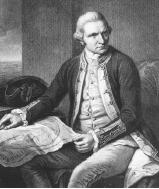Cook, Captain James
British Explorer
1728–1779
Captain James Cook added more to early knowledge of the southern Pacific Ocean and the western North American coast than any other person. Among his contributions, he surveyed the St. Lawrence River, the transit of Venus across the Sun's disk from Tahiti, and the unexplored east coast of Australia (then claimed British possession); explored the southern oceans in search of a continental land mass (Antarctica); discovered New Caledonia, Norfolk Island, and the Sandwich Islands (Hawaii); and showed that a

Early Life
Cook was born near Whitby, Yorkshire, England, and received a limited education. After apprenticeships with a storekeeper and with ship owners at Whitby, he joined the British Navy and rose in rank rapidly. As a navigator, he surveyed the St. Lawrence River and played a significant role in the capture of Quebec. He spent the summers from 1763 to 1767 surveying the coastline of Newfoundland. The Royal Society took interest in Cook after his observations of a solar eclipse in 1766 helped establish the longitude of Newfoundland.
Life's Work
Cook's first voyage in command began in 1768, when he was appointed commander of an expedition to Tahiti to observe the transit of Venus across the disk of the Sun and, clandestinely, to look for new lands in the southern Pacific between Chile and New Zealand. His ship, the Endeavour, surveyed the coasts of New Zealand and reached the unexplored coast of Australia. He named the region New South Wales. The Endeavour sailed inland of the Great Barrier Reef, nearly wrecking on coral, and explored the coast of Queensland.
Soon after the first voyage, Cook sailed as captain of the Resolution, accompanied by Tobias Furneaux and the Adventure, to explore the southern oceans and the mythical southern land mass as near to the South Pole as possible. They crossed the Antarctic Circle in 1773 before turning northward to Tahiti for supplies and respite from the bitter cold. Cook thereafter lost contact with the Adventure, which returned to England by way of the first west-east circumnavigation of Earth. Cook continued his search for a southern continent (Antarctica), making numerous island discoveries.
In 1776, Cook set out on the Resolution, later accompanied by the Discovery, commanded by Charles Clerke. They went in search of the vaunted Northwest Passage, which was thought to exist between the Pacific and Atlantic Oceans. En route, the ships revisited New Zealand, Tonga, and Tahiti. In 1778, Cook found and named the Sandwich (Hawaiian) Islands. He then sailed to the coast of North America, which he followed northward through the Bering Strait and into the Arctic Ocean. Returning to the Hawaiian Islands for supplies in 1779, Cook was murdered by natives over a dispute involving a stolen boat. Both ships continued, without success, to look for a passage south of the Arctic Circle between the Pacific and Atlantic Oceans before returning to England.
SEE ALSO Navigation at Sea, History of .
E. Julius Dasch
Bibliography
Cook, James. Explorations of Captain James Cook in the Pacific As Told by Selections of His Own Journals, 1768–1779, ed. A. Grenfell Price. Mineola, NY: Dover Publications, 1971.
Hough, Richard. Captain James Cook. New York: W. W. Norton & Company, 1997.